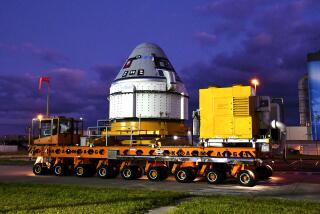Shuttle Fuel Leak Fixed on Launch Pad
- Share via
KENNEDY SPACE CENTER, Fla. — Technicians on Friday sealed a leaky fuel line to a steering engine compartment of the space shuttle Discovery, taking another step toward launching in late September or early October, NASA officials said.
Working in cramped quarters in the shuttle’s up-ended cargo bay, engineers first bolted a clamshell-shaped device onto a line found to be leaking nitrogen tetroxide gas more than a month ago.
Once the clamp was in place, the technicians filled it with a sealing compound and subjected the line to pressure tests. Karl Kristofferson of the National Aeronautics and Space Administration said initial results indicated the leak had been stopped, but the seal is to be monitored for several more days.
If the seal holds and if initially encouraging results of booster rocket tests in Utah hold up, officials said, the space agency next week may set a new date for launching. The Discovery mission will be the first since Jan. 28, 1986, when the shuttle Challenger blew up shortly after liftoff and its crew members were killed.
NASA officials have been considering scheduling the Discovery launch for late September or early October, perhaps on Sept. 29.
To reach the nitrogen tetroxide leak, the workers used an electric router to drill holes through the rear wall of 60-foot-long cargo bay and through the adjoining hull of a steering engine compartment.
The tiny leak was 12 inches from the newly drilled access panels, on a fitting in a vent line.
When the leak was discovered, officials at first feared they might have to move the shuttle off the launching pad and into a hangar for repairs, a move that could have delayed the mission into November or later.
Still to be resolved is a hydrogen leak in another part of the shuttle that was detected during a fuel-loading exercise and again later, during test-firing of the main engine on Aug. 10.
NASA officials said that leak, which shows up only when the external tank is pressurized for launching, was not considered hazardous, but that managers must demonstrate that it would not get worse during flight.
More to Read
Sign up for Essential California
The most important California stories and recommendations in your inbox every morning.
You may occasionally receive promotional content from the Los Angeles Times.










